IN THIS ISSUE
- Don't underestimate owls
- Cabbage white: devil or angel?
- Watch for manatees, sea turtles
- Atlanta peregrines' new penthouse
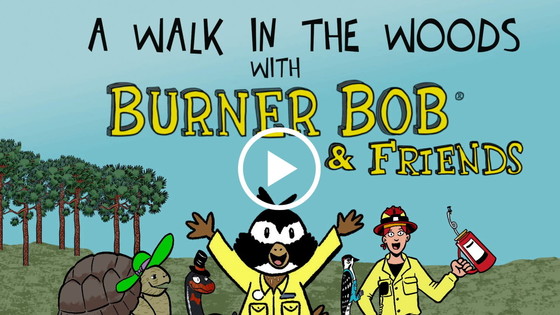 In the just-released “A Walk in the Woods with Burner Bob,” join prescribed burner Shan Cammack and some spunky fire ecologist friends as they visit The Fire Forest. Along the way, viewers will meet many of Burner Bob's plant and animal friends who thrive when their longleaf home is burned regularly.
With videography and custom animation, the video is designed to engage people of all ages. Share it with the young "saplings" and educators you know.
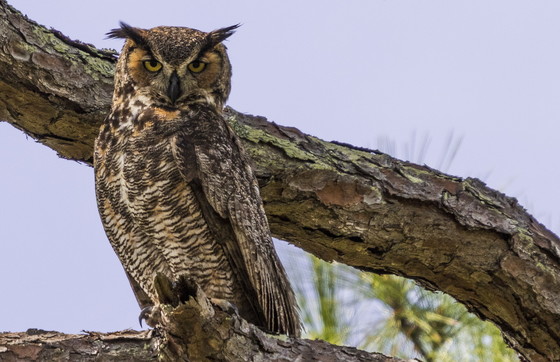 Great horned owl (Marcia Brandes/GNPA)
Stuffy, bespectacled, benign: Cartoon owls may be fun but they are oh so far from reality. The wild truth is that owls are raptors not to be trifled with.
Consider the great horned owl that attacked a bald eagle on camera at Berry College. Or the great horned that delivered to its nest as prey a barred owl, a slightly smaller cousin.
“They don’t seem to have any fear,” said DNR wildlife biologist Todd Schneider.
Four owl species are known to breed in Georgia: eastern screech, barred, great horned and barn. A few others – northern saw-whet, burrowing and short- and northern long-eared – are occasionally reported. Each of the mainstays packs a punch, from robin-sized screech owls to the great horned owl with its 4-foot-plus wingspan.
And there’s more than just a never-say-can’t attitude. Owls have a whisper quiet flight, superb night vision, hearing sharpened by facial shapes and feathers that funnel sound to their ears, swivel-like necks (barred owls can rotate 270 degrees in each direction) and needle-tip talons powered by an impressive grip – 500 pounds per square inch for great horneds, the better for severing the spine of prey.
No wonder everything from cicadas and frogs to skunks and wild turkeys are on the menu for owls.
When it comes to hunting, territorial disputes or simply reminding a bald eagle who’s boss after sunset, Georgia’s owls can be anything but owlish.
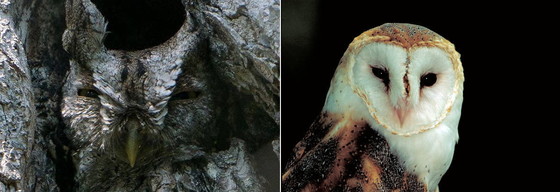 Side-eyes from a screech owl, left, and barn owl (Danielle Brigida, Thomas Barnes/USFWS)
FOR MORE
- Watch great horned owls raising an owlet at The Landings near Savannah.
- Identify who's calling here and here.
- Heard about the barred owl swooping on residents in an Atlanta neighborhood? While owls and other raptors will sometimes try to drive away people who are near their nest, “This is not that,” said Kaitlin Goode, manager of DNR’s Urban Wildlife Program. Goode thinks the rouge bird was raised by someone and released, imprinting it on people as providers of food. DNR is working to trap and relocate the owl.
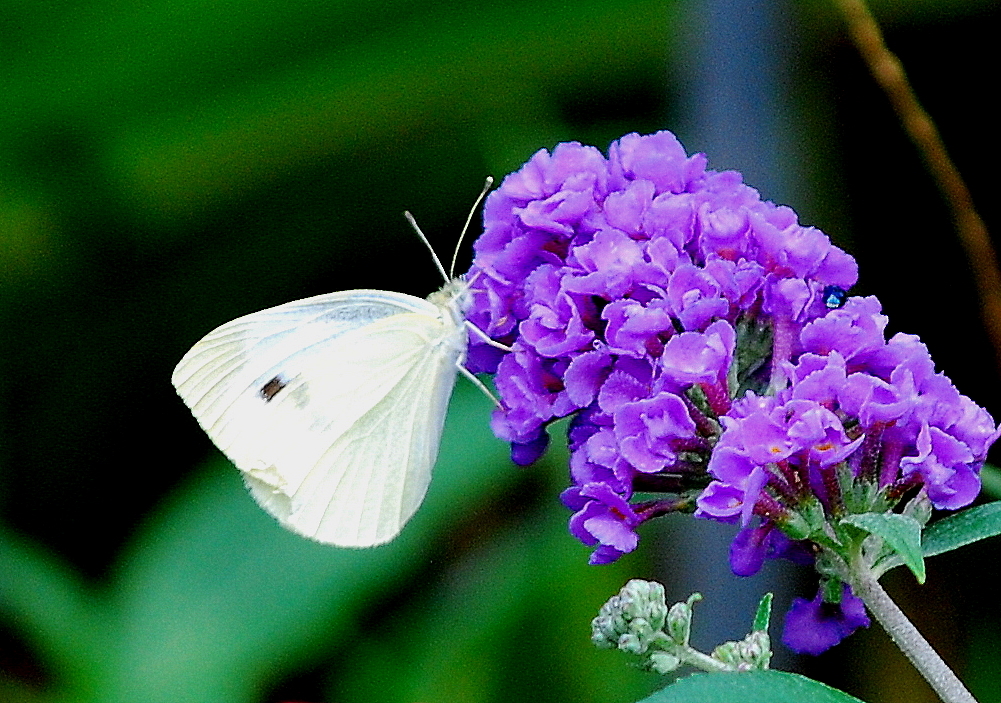 Cabbage white butterfly (Terry W. Johnson)
By TERRY W. JOHNSON
Back when I was younger and had a full head of hair, one of the songs often played on the radio was “Devil or Angel.” The lyrics began, “Devil or angel, I can’t make up my mind which one you are …”
Although the song dealt with the trials and tribulations of teens in love, in a way it could also apply to our relationship with the cabbage white butterfly.
Although Pieris rapae is beautiful, it is also one of a handful of butterflies considered a pest for crops and gardens. …
Read Terry’s column for a closer look at the pros and cons of cabbage whites.
Terry W. Johnson is a retired DNR program manager and executive director of TERN, the Wildlife Conservation Section’s friends group. Check out past columns, his Backyard Wildlife Connection blog and his book “A Journey of Discovery: Monroe County Outdoors.” Permission is required to reprint his columns.
 Manatee and calf (DNR)
With sea turtle and manatee sightings on the rise along Georgia’s coast, boaters should be on the lookout for these big and rare animals.
Boat strikes are a leading cause of sea turtle strandings and manatee injuries and deaths.
Tips on what to watch for in the coast’s murky waters differ. A “footprint” of swirls could mark a 9-foot-long manatee underwater. A 300-pound loggerhead sea turtle might show only its head when surfacing. Sea turtles spend more time on the surface in spring, putting them at greater risk of boaters running into them.
Of the 84 sea turtles stranded on Georgia beaches last year, 45 percent of those that could be assessed had injuries consistent with being hit by a boat. As for manatees, boat collisions have accounted for about 28 percent of manatee deaths in the state since 2000.
What can boaters do? Be vigilant, be ready to slow down or steer clear, and if you do run into a sea turtle or manatee, stand-by and immediately contact the DNR at 800-2-SAVE-ME (800-272-8363). Reporting collisions provides biologists the best chance to help the animals and gather data useful in conserving them. Boaters will not be charged if operating their boat responsibly and the collision was an accident.
 Four Seasons' Russ Ford, left, and DNR's Bob Sargent discuss the nest box. (Four Seasons Hotel)
Peregrine falcons have a standing reservation at Four Seasons Hotel Atlanta. Management at the midtown skyscraper worked with DNR to mount a nest box on the 50th floor, in hopes the world’s fastest birds – often spotted at Four Seasons – will turn the box into an aerie next winter.
Although survey flights will continue off the Carolinas until mid-April, this calving season for North Atlantic right whales has been lackluster, according to DNR senior wildlife biologist Clay George. Fifteen calves were seen, too few to offset the endangered whales’ decline. More insights in next month's Georgia Wild.
The northern long-eared bat will be reclassified from threatened to endangered under the Endangered Species Act, according to a U.S. Fish and Wildlife Service proposal. Northern long-eared bats have been ravaged by white-nose syndrome, a disease that is killing cave-dwelling bats across the continent.
About 13,000 native grass plugs were hand-planted in loblolly pine stands at Chickasawhatchee Wildlife Management near Albany. The wiregrass and lopsided Indiangrass will help improve the habitat for grassland birds such as bobwhite quail and Bachman’s sparrows and add fuels needed for prescribe fire.
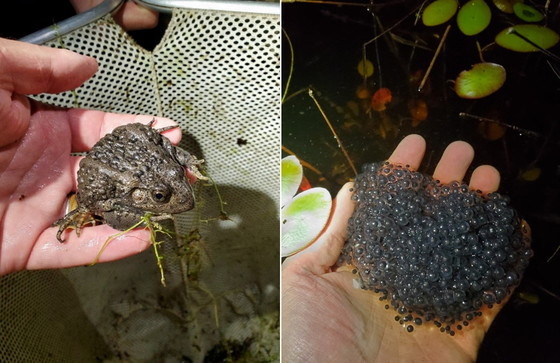 Gopher frog and egg mass from Sandhills WMA (DNR)
Gopher frogs did more than just call this breeding season at Sandhills Wildlife Management Area. Wetlands at the Taylor County property yielded eight egg masses, some of which will be reared at the U.S. Fish and Wildlife Service’s Warm Springs National Fish Hatchery in a project with UGA, Gaskins Forest Education Center and Amphibian Foundation to restore populations of the rare frogs.
Black bears are on the move: Do you know the basics about living responsibly with them? Learn more in this video and at BearWise.org.
From informing beachgoers about shorebirds to adding viewing platforms at Hard Labor Creek State Park near Rutledge, DNR's latest Wildlife Viewing Grants recipients will help connect Georgians with native animals and plants, particularly species emphasized in Georgia's State Wildlife Action Plan. Check out coverage of grant recipient Betty’s Garden.
The 15 finalists for this year’s Conserve Georgia grants include developing Long Swamp Creek Recreation Area in Cherokee County, adding trails and restoring stream buffers in Atlanta’s Woodall Creek Conservation Corridor, building a Discovery Zone geared to education at Charlie Elliott Wildlife Center in Mansfield and acquiring lands to expand FDR State Park near Pine Mountain and Chattahoochee Fall Line Wildlife Management Area in Marion County.
 Youth Birding Competition team members check out their wingspan (Rick Lavender/DNR)
Quick hits:
- Today is the last day to register for DNR’s 2022 Youth Birding Competition, set for April 15-23 and offering teams virtual and in-person options.
- A U.S. Fish and Wildlife Service review found that Georgia bully, a flowering shrub found in riparian forests and forest wetlands in Georgia, Florida and Alabama, does not warrant federal listing.
- Bat maternity season is April 1-July 31 in Georgia, which means excluding the protected mammals from a site they're using is off-limits until afterward.
- Manomet is recruiting volunteers for a bird ambassador program on Tybee and St. Simons Island beaches to tell visitors about shorebirds, seabirds and barrier island habitats.
- Trout stocking is in full swing, and anglers can learn more and sign up for weekly stocking updates at georgiawildlife.com/fishing/trout.
- Turkey season opens Saturday on private lands and April 9 on public lands.
- Partners of the revised Stream Crossings in Georgia handbook used International Day of Action for Rivers (March 14) to highlight the guide to wildlife-friendly infrastructure such as bridges and culverts.
- Fish records are made to be broken, with recent catches setting new Georgia marks for longnose gar and hickory shad.
Names in the news: Georgia Wildlife Federation President Mike Worley explained how Recovering America’s Wildlife Act will help bobwhites and other species in a National Wildlife Federation blog post. UGA professor Susan Wilde and Timo Niedermeyer, of Martin Luther University Halle-Wittenberg in Germany, received the American Association for the Advancement of Science’s Newcomb Cleveland Prize for research identifying the link between a cyanobacteria and brain lesions killing bald eagles and other wildlife around reservoirs.
WHAT YOU MISSED ...
In the previous Georgia Wild:
- Whigham won't use wild snakes
- Capt. recounts 2021 whale collision
- Breeding breakthrough for rare sallies
- Terry Johnson on planting pineapple sage
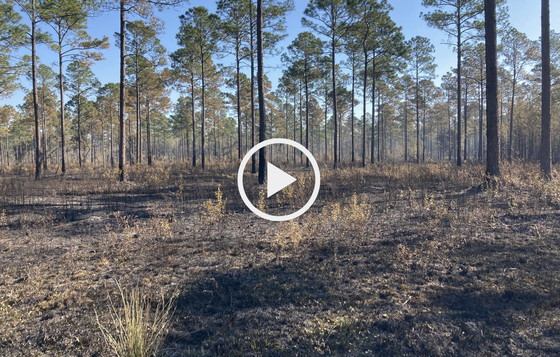 Prescribed fire at Ceylon WMA, DNR
Wrapping up fall red knot research in Georgia, DNR
DNR's Joe Burnam discusses red-cockaded woodpeckers at Silver Lake WMA, Georgia Power
(audio) DNR state turkey biologist Emily Rushton previews turkey season, O'Neill Outside
"Flamingo that escaped Kansas zoo 17 years ago seen in Texas," CBS News
"Research verifies invasive tegus adaptable to many climates," U.S. Geological Survey
"Man behind Valdosta snake scare sentenced to prison," Valdosta Daily Times
"Meet one of the South’s strangest, and rarest, amphibians," Garden & Gun
"End of Ga.'s live-catch rattlesnake roundup finishes cultural phenomenon," SaportaReport
"Fla. sportfishing captain describes fatal right whale strike," Coastal News Today
"Call for change in treatment of endangered woodpecker," GPB
"It's illegal to kill nonvenomous snakes in Ga.," WGXA-TV (Chs. 24, 16, Macon)
"In-person, virtual available for DNR youth birdathon," Jackson Progress-Argus and others, including Yahoo!News
"What youth can discover by birding" plus "Keep the fire going" and "We're here to help: DNR Urban Wildlife," articles in summer/spring Georgia Great Places
"Precision conservation saves time, money, species (in Ga.)," Phys.org
"Six projects receive DNR wildlife viewing grants," The Albany Herald. Also: "Lost Creek Forest Friends get $3K grant" (Thomasville Times-Enterprise); "Phinizy Swamp gets grant for boardwalk," WRDW/WAGT-TV (Chs. 12, 26, Augusta)
"UGA breaks ground on Experiential Learning Center at Wormsloe," UGA Today
(+video) "Climate change may be drawing right whales out of Gulf of Maine," WCSH-TV (Ch. 31, Portland, Maine)
"Why whales don't drown when they gulp down krill," ScienceAlert (study)
"Effort to save brown trout becomes model for saving Chattahoochee," The Atlanta Journal-Constitution
"River Network launches Georgia River Guide app," Calhoun Times
"Restoring trail that honors children killed in 1991 plane crash," SaportaReport
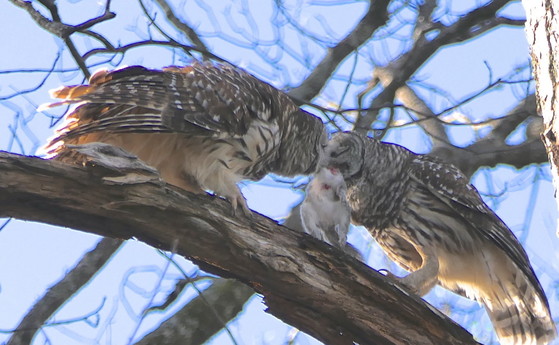 While we're on the subject of owls, Linda May, outreach coordinator for DNR’s Wildlife Conservation Section, passed along this photograph of a barred owl couple sharing a gray squirrel. As May wrote, "Nothing says 'I love you' quite like a headless squirrel offering.” The owls are also sharing a nest box in the Mays' yard.
CREDIT
Georgia Wild masthead: barred owl (Guerry Doolittle/GNPA)
Top
|